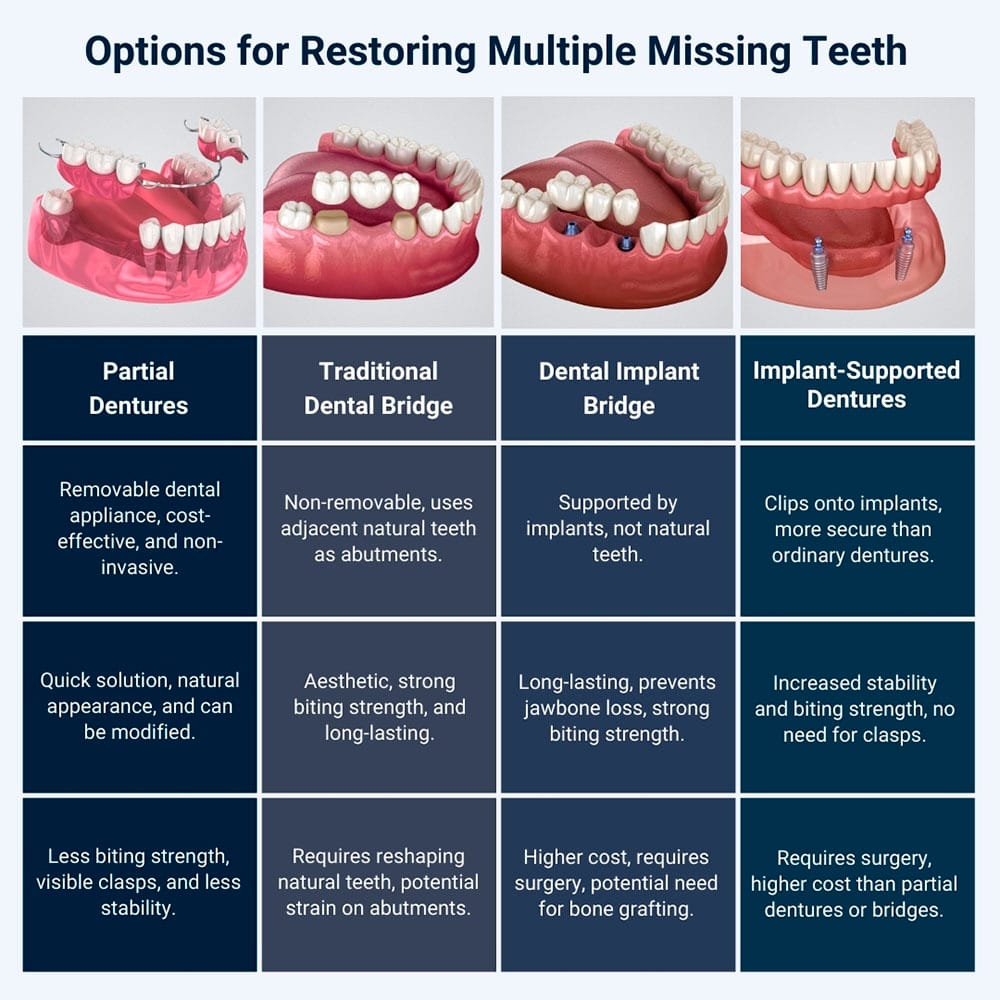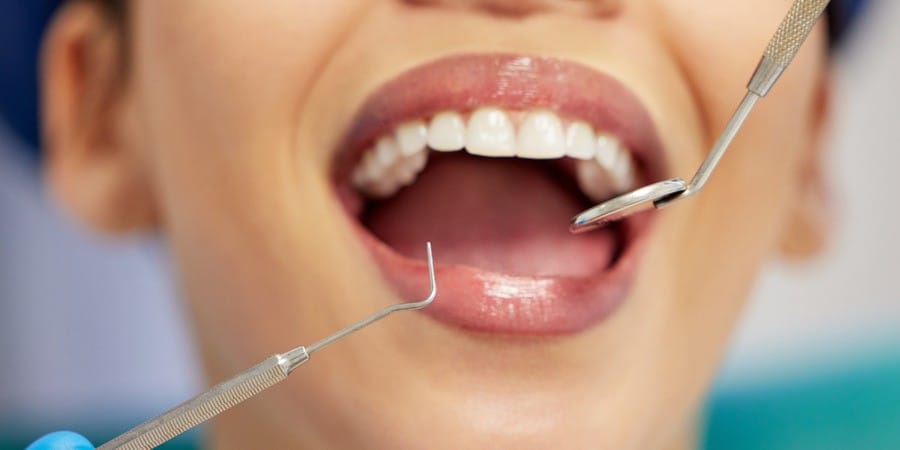What Can Cause Tooth Loss?
Common causes for multiple missing teeth can include:
- Trauma or an accident
- Severe tooth decay or infections
- Severe gum disease (periodontitis)
- Congenitally missing teeth
Why Replacing Multiple Missing Teeth Is Important
Reasons for restoring missing teeth include:
- Except for wisdom teeth, every tooth in your mouth has an important role and supports its neighbor.
- Having all of your adult teeth helps share the stress created when you bite and chew, prevents your teeth from shifting out of place, and helps protect your bite.
- A complete set of teeth ensures you can eat properly, increasing your choice of foods and making it easier to choose more nutritious items. A good diet helps support your overall health.
- Without a full complement of teeth, there is a risk you could develop a lisp or other speech issues; replacing missing teeth helps avoid these problems.
- Your teeth are perfectly designed to provide the right support for your facial muscles. They also help maintain your facial dimensions and the height between your upper and lower jaws.
- Without teeth, there is a risk that your facial features will collapse inward, prematurely aging your appearance.
Options for Restoring Multiple Missing Teeth
Several options exist and include:
- Partial dentures
- Traditional dental bridge
- Dental implant bridge
- Implant-supported dentures

Partial Dentures
A partial denture is a removable dental appliance and is the most cost-effective and least invasive way to restore multiple missing teeth. The teeth it replaces do not need to have originally been side-by-side.
Partial dentures can be made from acrylic or nylon.
Acrylic partial dentures are often strengthened with a lightweight metal framework and have metal clasps fitting around your existing teeth.
Nylon dentures or Nesbit dentures are made from a flexible material. The nylon is slightly transparent, so these dentures are less noticeable, but they can lack the strength and stability of a more traditional partial denture.
A partial denture can be a good choice if you are looking for a quick solution. Also, adding more teeth to a partial denture may be possible later if you lose additional teeth.
Advantages and Disadvantages of Choosing a Partial Denture
Advantages can include:
- Treatment is cost-effective, quick, and non-invasive.
- There is a huge range of denture teeth to choose from, which can be arranged to look very natural.
Disadvantages can include:
- Partial dentures do not have the same biting strength as other tooth replacement solutions. You may find it trickier to eat certain foods.
- If you have an acrylic partial denture with metal clasps, these clasps could be quite visible in the mouth and can place stress on your natural teeth.
- A partial denture may be less stable in the mouth than other fixed solutions.
Traditional Dental Bridge
A traditional dental bridge can restore one or more teeth that were originally adjacent. It is non-removable and has crowns that are cemented over natural teeth that are adjacent to the gap.
These natural teeth are called abutment teeth and must be reshaped substantially so the crowns look and feel natural and comfortable. The replacement tooth or teeth are attached between the crowns and are called pontics. A pontic rests on the gum tissue and is shaped to look like a real tooth.
We can create beautiful, natural-looking dental bridges using the latest all-ceramic materials, including zirconia. Zirconia is incredibly strong and can restore a large span of multiple missing teeth.
Advantages and Disadvantages of Choosing a Traditional Dental Bridge
Advantages include:
- A traditional dental bridge can be ready to fit in two or more weeks.
- Modern ceramics look aesthetically pleasing.
- Traditional bridges have good biting strength that is similar to natural teeth.
- A dental bridge can last ten or more years with proper oral care and maintenance.
Disadvantages can include:
- We must reshape the abutment teeth substantially before covering them with dental crowns. Removing this natural tooth structure can increase the risk of these abutment teeth becoming infected and decaying later, especially as the crowns age.
- A traditional bridge can place additional strain on the abutment teeth. Sometimes, these teeth may not be strong enough to support a bridge properly.
- Not everyone has abutment teeth that are suitable for a bridge. They may be too weak or missing entirely.
Dental Implant Bridge
A dental implant bridge works similarly to a traditional bridge but is supported by implants instead of natural teeth. Small implant screws or posts are inserted into your jawbone where they can hold a non-removable bridge firmly in place.
The bridge will look just like a traditional bridge, except it is most likely screwed onto the implants rather than being cemented onto natural teeth. The screws fit right through the implant bridge and are covered with tooth-colored composite resin so they cannot be seen.
The advantage of screwing the bridge in place is that we can retrieve it later if we need to carry out any maintenance or to clean it professionally.
Advantages and Disadvantages of Choosing a Dental Implant Bridge
Advantages include:
- Dental implants are a long-lasting tooth loss solution. Some people will enjoy them for life.
- Dental implants help prevent jawbone loss by preventing jawbone resorption around the implants.
- An implant bridge provides a biting and chewing strength similar to natural teeth.
- Dental implants help protect your remaining teeth, preventing them from moving out of place and sharing the stress and strain of biting and chewing food.
- We don’t need to replace every single tooth with an implant. Instead, two or more implants can support a relatively large implant bridge.
- An implant bridge is a good solution if you do not have natural teeth that are strong enough to support a traditional bridge or are missing entirely.
Disadvantages can include:
- Dental implants are initially more expensive because of the implant components and technology needed to plan and place them.
- Oral surgery is needed to insert the implants. Not everyone is suitable for this treatment or wishes to have the surgery.
- If you lost teeth quite some time ago or had severe periodontitis, your jawbone may have resorbed, and we may need to carry out a bone grafting procedure before inserting the implants. This would mean an additional procedure and increase the overall costs.
Implant Supported Dentures
An implant-supported denture is like an ordinary denture but clips onto dental implants. It is much more secure than an ordinary denture; you can snap it in and out of your mouth for easy cleaning.
Advantages and Disadvantages of Choosing Implant-Supported Dentures
Advantages include:
- An implant-supported denture is self-supporting, so there is no need for clasps to fit around your natural teeth.
- Treatment is suitable if you have no suitable teeth for a traditional bridge or where they are missing entirely.
- An implant denture provides increased biting strength compared with an ordinary partial denture.
- Treatment is more cost-effective compared with a dental implant bridge.
- An implant-supported denture is stable and will remain firmly in place without messy adhesives.
Disadvantages can include:
- Just like a dental implant bridge, surgery is needed to insert the dental implants.
- You may need bone grafting if you lost teeth quite some time ago and have suffered jawbone resorption.
- Treatment is more expensive than a partial denture or a traditional dental bridge.
Costs of Replacing Multiple Missing Teeth
We understand that the cost of replacing missing teeth is an important factor. The price of your treatment depends on how many teeth we need to replace and your treatment choice.
The most cost-effective solution is a partial denture. The most expensive is a dental implant bridge. Dental insurance may meet part or most of the costs of replacing multiple missing teeth, depending on your coverage.
Do you have multiple missing teeth or face imminent tooth loss? Contact Clock Tower Dental to discover how to fix missing teeth. After assessing your dental and general health and discussing your treatment goals, we can recommend a suitable plan to restore your smile. Learn more about our comprehensive services designed to address your unique dental needs and ensure optimal oral health.

